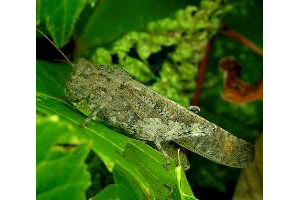The somewhat related desert locust, which is mentioned in the Bible, is among the few land animals known to cross the Atlantic Ocean unaided by humans. Migrants out of Africa occasionally reach the Caribbean islands.
Photo Credit: J.C. Lucier
Dissosteira carolina
Common Name: Carolina locust
Other Common Names: Carolina grasshopper
Animal Guild: Insect
Class > Order > Family: Insecta > Orthoptera > Acrididae
What does the species look like?
This is a large grasshopper with a body up to two inches long and a wingspan of between three and four inches. Adults and nymphs are cryptic on the soil, being variable shades of grey, tan, brown, or reddish brown with subdued markings. However, flying or hovering adults are easily recognized even at tens of yards away by the black hindwings which have a pale yellowish-white border. Although some observers may mistake the flying adults for butterflies, recognition is easy in most of the range. Only the High Plains Grasshopper (D. longipennis), found mostly in the southern Great Plains region, is at all similar. Carolina locust nymphs look like miniature adults and after several molts they have conspicuous but stubby, non-functional wings. Only the final adult stage has functional wings.
Where is the species found?
States & Provinces
AR, AZ, BC, CA, CO, CT, DC, DE, GA, IA, ID, IL, IN, KS, KY, LA, MA, MD, ME, MI, MN, MO, MS, MT, NC, ND, NE, NH, NJ, NM, NV, NY, OH, OK, ON, OR, PA, RI, SC, SD, SK, TN, TX, UT, VA, VT, WA, WI, WV, WY
Distribution
The Carolina grasshopper occurs in southern Canada from Nova Scotia to southern British Columbia and in all of the lower 48 U.S. states, as well as a small portion of Mexico. The Carolina grasshopper is not normally found in most of Florida, along the Gulf coast, or in southern Arizona and coastal California.
Carolina grasshoppers prefer hot, dry, open habitats with patches of bare, disturbed, sun-exposed ground which they use for basking and where females lay eggs. In the east disturbed habitats like roadsides, ditches, little used gravel roads, railroad sidings, field margins, and playgrounds are typical habitats, and they sometimes occur on more natural shorelines. In the west, they occur commonly on rangelands and in most dry, sparsely vegetated natural communities including shale outcrops, primarily along roads or where the soil has been disturbed.
General Phenology and Life History
The Carolina grasshopper has one annual generation throughout its range. The eggs overwinter underground and nymphs hatch over several weeks in the spring. The nymphs molt about eight times before becoming flying adults. Development from egg to adult usually requires less than two months. Adults appear in June or July in most parts of the range and are present until September or October. Males occasionally rise almost vertically from a patch of bare ground to hover for about 8-15 seconds, at heights of 3 to 6 feet and emit a soft sibilant or lisping sound. They then flutter down to the ground close to where they started, and repeat the process a few times. These apparently are courtship displays, but they also attract other males in addition to potential mates. Males can also make a soft stridulating sound when perched. Several days or more after mating, the female deposits about 50 eggs enclosed in a curved pod in the soil. Females lay several egg pods over a lifetime. All stages feed almost entirely on living foliage of many kinds of forbs and grasses. Despite its large size and appetite, this grasshopper is not generally a significant crop pest and is at most of minor economic importance on rangelands. Adults have been documented to disperse more than ten miles, but massive migrating swarms have not been reported.
Which phenophases should I observe?
Do you see/hear...?
Activity
Adults More...
For abundance, enter the number of individual animals observed in this phenophase.
Adults feeding Dissosteira carolina , adults feed on many different forb and grass species.
For abundance, enter the number of individual animals observed in this phenophase.
Reproduction
Courtship calling Dissosteira carolina , these are clicking and buzzing sounds, often made while in flight.
What is the intensity of calling?
Single calls: There is space between calls and individuals can be counted. Overlapping calls: Calls of individuals can be distinguished but there is some overlapping of calls. Full chorus: Calls are constant and overlapping.
Mating For abundance, enter the number of individual animals observed in this phenophase.
Egg laying Dissosteira carolina , females insert the egg laying tube (ovipositor) at the back end of their body into the soil to lay eggs under the surface.
For abundance, enter the number of individual animals observed in this phenophase.
Development
Nymphs Dissosteira carolina , nymphs look similar to adults, but their wings are absent or only partially developed and they cannot fly.
For abundance, enter the number of individual animals observed in this phenophase.
Nymphs feeding Dissosteira carolina , nymphs feed on many different forb and grass species.
For abundance, enter the number of individual animals observed in this phenophase.
Dead adults For abundance, enter the number of individual animals observed in this phenophase.
Dead nymphs For abundance, enter the number of individual animals observed in this phenophase.
Method
Individuals at a light For abundance, enter the number of individual animals observed in this phenophase.
Individuals in a net For abundance, enter the number of individual animals observed in this phenophase.
Individuals in a trap For abundance, enter the number of individual animals observed in this phenophase.
What do these phenophases look like?
There is currently no photoguide available for this species. If you'd like help us create one, use the guidance document and species template provided here . Then send it via email to education@usanpn.org when it is complete.
